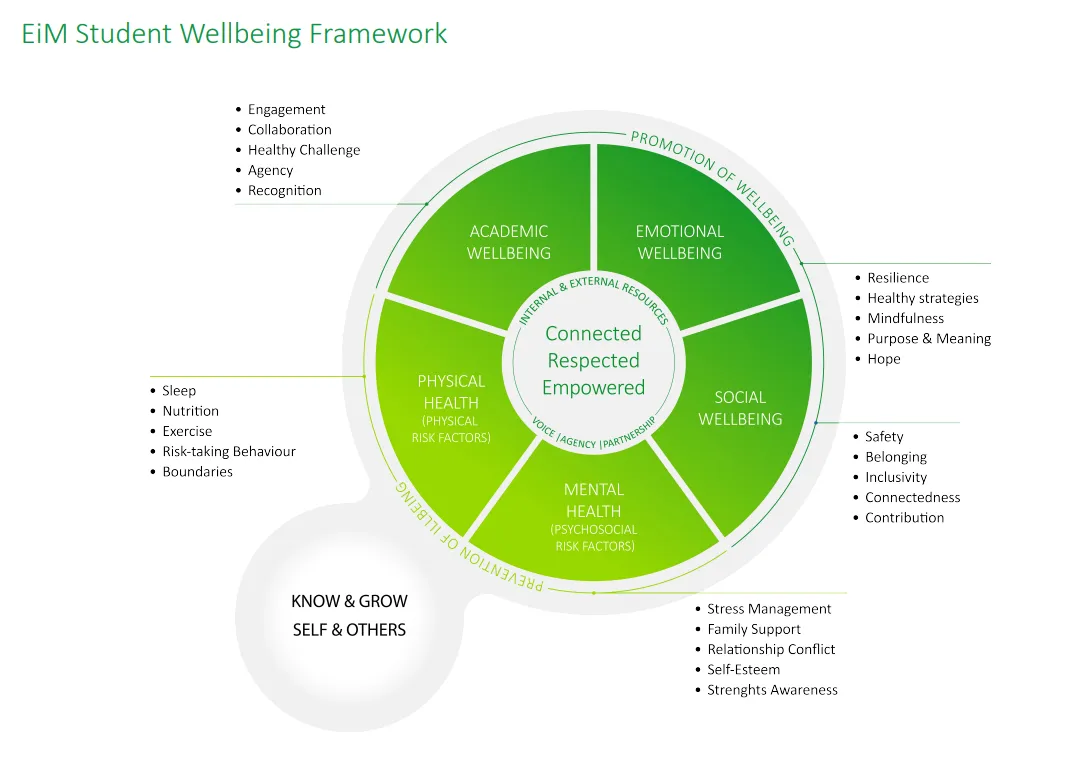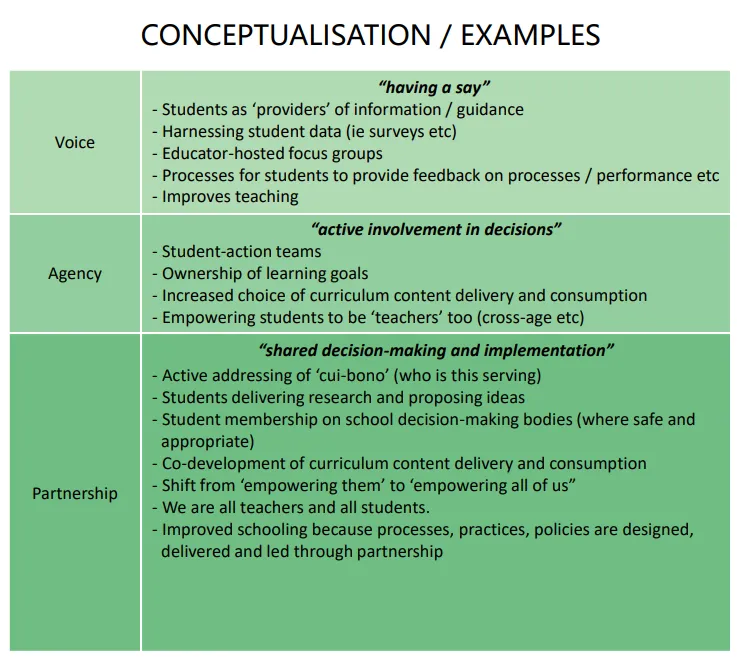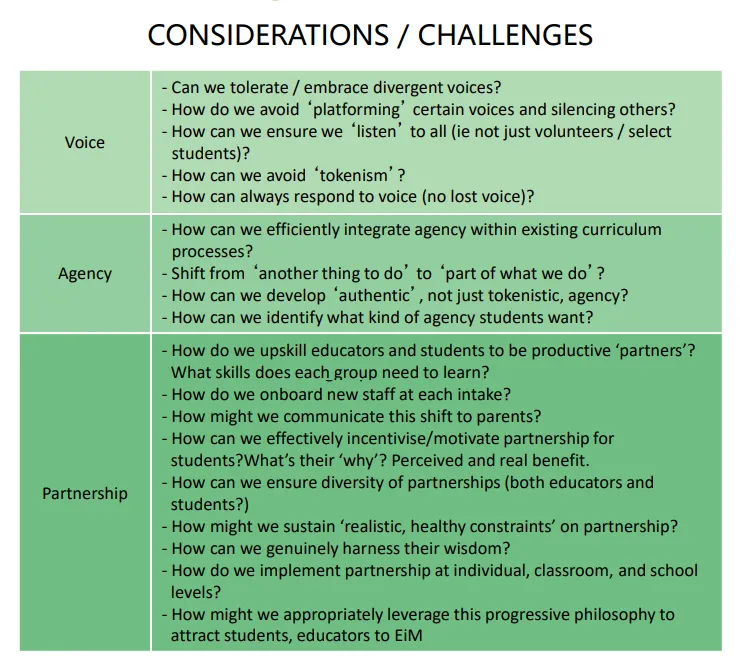EiM Launched Newly Updated Student Wellbeing Framework
“At EiM schools, our students are our top priority. We’re dedicated to making sure our students feel safe, supported, and happy in our school communities. Their wellbeing, needs, and talents are at the heart of everything we do.”

Lesley Meyer
Chief Education Officer
Education in Motion (EiM)
Wellbeing is a whole group culture which ensures that every member of the community can flourish. In supporting our students to enhance their wellbeing, our ultimate goal is that our students develop and are able to contribute positively to the wider community with meaning and purpose.
It was increasingly clear that in order for our students to be fulfilled, successful and purposeful in their studies and their life, we had to develop a framework that every school could use to guide how student wellbeing addressed the unique needs of every student, in every school.

The EiM Student Wellbeing Framework provides the best mechanism to capture the diverse requirements of a Wellbeing agenda articulated through both the taught curriculum and co-curricular programmes across schools at any age or stage of development.
EiM recently launched the newly created Student Wellbeing Framework. Sarah Tielman, Head of Dulwich International High School Suzhou, Student Wellbeing Framework Lead, is positive about our group‘s commitment and practice:
“Everyone in the group is 100% committed to prioritising student wellbeing in each of our schools. Every school and every student is different, so we made sure that our new framework was descriptive, but not prescriptive. It was designed to give us a framework to talk about, audit and prioritise wellbeing for students, while allowing each school to tailor their approach to wellbeing according to the unique needs of their students and their community.”

Sarah Tielman
Head of Dulwich International High School Suzhou
Student Wellbeing Framework Lead
What is the EiM Student
Wellbeing Framework?

The EiM Student Wellbeing Framework is a comprehensive model for student wellbeing which is designed to provide a foundation for future wellbeing strategy and implementation across the group.
The model was grounded in four core assumptions that have informed the development of the domains and sub-domains within the framework:
- There is nothing more important for EiM than the health and wellbeing of our students and the EiM community.
- The responsibility for the wellbeing of each individual student is shared by the community and the fostering of student wellbeing should be prioritised equally – inside and outside the classroom.
- Leadership and staff recognise that there is valuable, actionable wisdom uniquely inherent in the perspective, sentiment, and voice of students.
- EiM's health and wellbeing approach is designed to directly address the causes of student illbeing, by acknowledging risks like stress, self-esteem, and relationship conflict.

How will we engage
with students?

This framework views student engagement as a continuum of possibility and appropriateness. The overarching intent is for students to be engaged in dialogue at some level in all elements of schooling that affect their wellbeing.
'Voice' constitutes the lowest level of engagement, 'Agency' is the middle level, and 'Partnership' is the highest level of engagement. Already in our schools we are seeing exciting initiatives that engage students across the spectrum. From surveys offering students a 'voice' to express their feedback on their learning experiences. To students leading peer-to-peer mental health support in 'partnership' with school staff.
Examples & Considerations of
Voice | Agency | Partnership
Consideration will always need to be given to the developmental stage of different student cohorts. Whilst the framework and underpinning philosophy have been designed to be universal, the approach to student engagement will always focus on conceptualising and differentiating the levels within each unique school context.
How was the framework
developed and how will it be
implemented?

In order to address the crucial aspects of student mental health and wellbeing within the EiM Group, a comprehensive approach has been undertaken. The framework was developed as a consultative process with staff and students from across the group of schools. This consultation, informed the co-creation of a comprehensive draft model for student wellbeing, providing a foundation for future wellbeing strategy and its implementation across the EiM Group.
In addition to the framework, an accompanying Wellbeing Implementation Assessment Template was designed to be used by school staff to identify opportunities for growth, guide strategy, and share best practice. Implementation will be managed at school level, with staff using the framework in support of conversations and decision making to identify the exact strategies and approaches that are right in each school to meet their student needs.
How could parents contribute,
in collaboration with schools,
to support students' wellbeing?

By providing students and families with integrated and holistic support systems that focus on all areas of individual development, ability and interests, underpinned by the EiM Student Wellbeing Framework, our students are provided with a supportive environment in which to learn and grow.
The home-school partnership is essential when we are considering our students wellbeing. Each school will already have many initiatives in place to educate and support parents throughout their child's education journey. Parents are encouraged to reach out to their child’s teacher when they have concerns or questions, to be engaged and interested in their child’s learning and to attend school events. A close connection between home and school will offer the best chance of promoting positive wellbeing for your child and enhancing the work that schools have begun around the EiM Student Wellbeing Framework.
Connect with us








